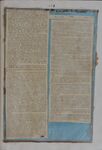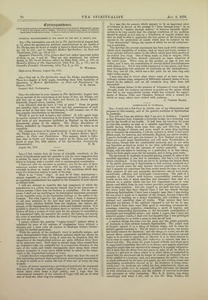< The Ring Test (continued from page 7-218) >
stood the word “interlinking” in relation to our request about the rings, for once he gave us a paper ring cut in two in a remarkable way, and spirally, all done in the dark—a wonderful performance in itself. So I advised Herr Gillis to really interlink two paper rings, by cutting open one and pasting its ends together, after threading it on the other, to show Peter by ocular demonstration “the look of the thing.” “Oh! I see what you mean!” Peter said, with his peculiarly melancholy tone of doubt. “Can’t be done!” he sadly continued. But the other spirits encouraged us, although they said that it might not be accomplished this time. Again Herr Gillis declared himself perfectly satisfied with what he had already obtained, and kept up the harmony by the kindest remarks to the spirits and attention to the mediums, the only way to get the best results.
Herr Gillis next invited the mediums to a friendly supper in his room. Mr. and Mrs. Herne could not come, so Mrs. and Mr. Williams and myself were the only guests, besides the spirit “Peter,” who partook of some champagne to wash down the piece of fowl handed to him under the table, both the liquid and the solid substances being dematerialised only, as he explained on being asked how he managed to cause them to disappear. Other remarkable facts which occurred the same evening I pass by, and come to last Friday morning’s sitting, when Mr. Rita joined the already strong force of mediums, after having delighted us with a splendid seance the previous evening. On this occasion, after giving manifestations which greatly pleased Herr Gillis, John King wound up with a fine slate-writing test under absolute conditions. Herr Gillis had his hands on the double slate, and we all plainly heard the writing produced, which runs thus:— “My dear friends,—We have done our best for you. We will still try to do more to-morrow. For you, friend Reimers, there is good time coming. God bless you all.—John King.”
In the course of this seance I asked Peter why the test was so difficult. He replied: “If two bodies have thus to be interlinked, one should be big and strong to resist the action of the power.”
On Saturday last we had the farewell sitting, and all the four mediums seemed happy. The table was covered with refreshments, and seemed to claim a share in the last and crowning success. After several toasts, I expressed our thanks to John King, and my hope that all would now give him the lead in further proceedings. We went into the dark room, and no sooner was the light out than a perfect uproar ensued, and hammering and other noises began, impossible to describe. After John King ordered a light, we found the greater number of the wooden rings smashed like nutshells. This seemed to me a proof of the presence of great physical force. The deafening tumult contrasted with our own states of mind, which were cool and serious. After resuming our seats, we did not expect much after the sight of the smashed rings. Peter or Charlie invited my attention to two rings, asking me to feel them interlinked, which I did; so also did Herr Gillis. “It won’t keep,” Peter said, sadly, and he withdrew when we considered victory achieved. Again a hammering ensued, like a real carpenter’s shop, and Peter exclaimed, “There! There I There! Reimers! take hold of the ring! Mr. Gillis! hold it too! Don’t let go! Stick to it!”—and to be sure no power in the world would have forced our hands from this couple of rings. All the spirit voices were a-going until the signal for a light came, and there we had in our possession the two rings united. The effect was impressive alike to mediums and investigators.
After having on the road exhibited the new wonder to several friends, we went to a photographer to have a truthful picture secured of the strange phenomenon of a wooden and an ivory ring, each in one piece, interlinked, and forming a stone which the engine of science must either crack or itself leave the rails. Two rings, one of which could be cast, would be nothing; but before our rings either the charge of trickery must break down, or the brain insisting on trickery. Who was the medium? None; but all united, perhaps the whole circle; and with pleasure all we witnesses will interlink Dr. Slade’s name also with this success, for he has obtained something of the same kind. With a few more such results, many hostile elements may be harmonised, and science and religion may be interlinked, to be separated only by the destruction of the one or the other.
Ivory Rings
Sir,—I feel certain that all lovers of scientific exactitude in the study of Spiritualism must feel grateful to you for your suggestion that a section be made of the ivory ring which, I understand, has been taken to Leipzig, with a possible view to microscopical examination. I have not seen the specimen in question; yet, for the sake of those numerous readers who share with me this ignorance, it might be advisable to place on record now some of the conditions which may occur if a transverse section is made of the ring.
What is an “ivory” ring? It may be of three descriptions—animal, vegetable, or even of the compound mineral (?) nature, which an ingenious manufacturer has applied to the formation of such objects as billiard balls.
I will not attempt to describe this last compound, of which the manufacture is a patent, but merely remark that in the transverse or broken sections I have seen the fracture is crystalline. For the same reason I shall not say anything on the histological characters presented by the vegetable ivory, as the description belongs to the duties of the botanist. But with regard to the animal ivory, I deem it necessary to call your attention to the fact that each several description of animal ivory, whether derived from the elephant, the walrus, the manoti, or the hippopotamus, shows a clear and definable section. It is possible to discover from the slightest shred or splinter, which may be broken off from a section of ivory (and, for the purpose of examination by transmitted light, the narrower the section the better), not merely the order of mammals from which the shred of ivory has been derived, but even the species.
I cannot indicate the peculiar “engine-turned” pattern which is exhibited by some of the sections of elephantine ivory without a diagram, and I must refer all readers to Professor Owen’s Odontography for further particulars.
While the pattern of the elephant’s ivory is perfectly unique, and easily distinguishable from the different patterns which are shown by the hippopotamus or other ivory, it must not be forgotten that the characters of the longitudinal sections are quite different from those of the transverse ones. Such rings as curtain rings, when turned from an elephant’s tusk, are naturally cut in a transverse direction to the axis of the tooth, and would consequently show along their round surface examples of every curve which would be taken by the transverse or the longitudinal sections of ivory.
I would therefore respectfully suggest to those who have the care of this interesting specimen that a preliminary microscopical examination be made to enable us to realise the fact of what sort of ivory the ring is made.
I have, of course, accepted as a provisional hypothesis the statement that one of the rings was really composed of ivory, and not of bone, which latter often bears a high polish; and I hope that the microscopical- botanists of the country of Unger will tell us of what sort of wood the other ring was composed.
In a case like the present, which appears to be an important piece of evidence in favour of the passage of ‘‘form through form,” or, as some term it, “matter through matter,’’ it behoves scientific Spiritualists to be very careful that the original conditions of the problem should be stated, as it is only on a foundation of exactly defined fact that we shall be able to appreciate the true nature of the forces which operate in the production of results which may be induced by the “four dimensional” things, the nature of which we are all endeavouring to ascertain.
The fact that the present experiment has been made with substances which show variability' of texture, such as wood and ivory, renders it of an entirely different nature to the effects which have been produced by welded iron rings. One of these, made in July or August, 1875, at Middlesboro’-on-Tees, showed externally no trace whatever of the secret joins. When rung on the ground, no sign of join was visible, and it bore the examination of several skilled iron-hammerers with glasses on. Yet it was really hammered in two pieces, and there were consequently two solutions of continuity on the circumference. This ring cost £1 12s., which was a fair price for an iron ring only eight inches across.
I may state that at seance after stance some of us have seen two ordinary curtain rings, composed of differently coloured pieces of wood, placed in the cabinet, and on all occasions they have been left untouched.
Such constant failure in the presence of witnesses of every shade of thought, leads the cautious speculator to ponder on the causes which have led to the unparalleled success which has crowned the experiments of Herren Gillis and Christian Reimers with a reward for which so many others have waited with patience,
Editor's notes
- ↑ Ivory Rings by Blake, C.Carter, London Spiritualist, No. 311, August 9, 1878, p. 70
Sources
-
London Spiritualist, No. 311, August 9, 1878, p. 70


